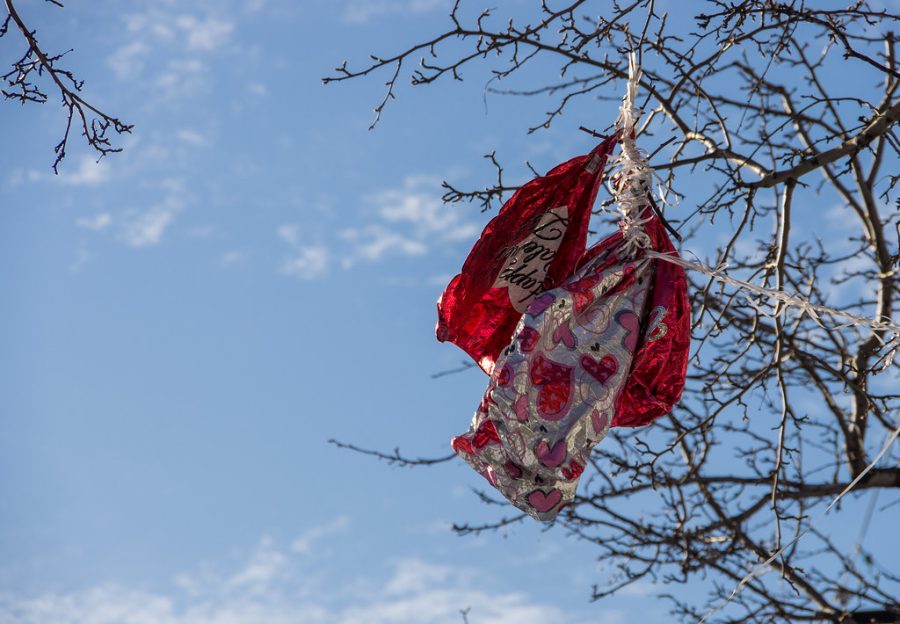Valentine’s Day is now a mockery of true love
Photo Courtesy of amseaman from Creative Commons
With Valentine’s Day comes ingenuine gifts, disappointments, and loneliness. The unrealistic balloon of love it claims to be is quickly popped with the realization of its materialistic qualities and stress-induction.
March 26, 2023
Boxes of chocolate, crimson roses and sparkling jewelry disappear from the shelves as anxiety-ridden lovers scurry to purchase all they can afford for their significant other. Eyerolls fill the masses as canoodling partners display their affection shamelessly. The plastering of bright pink hearts and materialistic gestures have invaded the day of romance.
The start of Valentine’s Day is unclear. One of the speculated origins of the holiday is the pagan fertility festival of Lupercalia, which used to be celebrated in Rome from Feb. 13 to 15. The story goes that on the day of the festival, two young priests stepped up to an altar and laughed as their foreheads were sliced and then wiped with milk-drenched wool. These naked men then cut pieces of sacrificed goat and dog hide and whipped women to promote fertility. Nothing romantic about that at all. Clearly.
In the sixth century, Pope Gesalius I was said to have replaced the savage festival with a celebration of Saint Valentine. There were two different priests by the name of Valentine, who were recorded to have been executed by Emperor Claudius II on Feb. 14 in the third century. These priests were men who cured a child of some sort of malady, influenced a full family conversion and then, consequently, were executed. But, Bollandists, scholars who research saints in Christianity, cannot find any historical account of a man named Valentine who was executed for illegally marrying couples — the story of Saint Valentine that is so commonly told. Once again, no hint of romance in the holiday of love’s supposed origins.
In fact, Valentine’s Day had no correlation with the celebration of romance until the fourteenth century when a writer developed a poem relating Saint Valentine to finding mates; in other words, the basis of the holiday is flimsy and there is not much of a reason to celebrate love and relationships on a day that truthfully has no connection to love and relationships.
Valentine’s Day not only lacks a base of romance, but it can impose feelings that are far from happy or romantic. For most adolescents, the idealized high school experience includes a romantic relationship at some point. In reality, only 35 percent of teens between the ages of 13 to 17 have dating experience according to the Pew Research Center. Valentine’s Day emphasizes the pressure for adolescents to be in a relationship. Teens can exaggerate what it means to “fit in” and not being in a relationship on a day dedicated to romance may make them feel inadequate.
Although the pressure to be in a relationship is not unique to teenagers, teenagers are especially vulnerable to peer pressure. In today’s society, people feel a need to flaunt their relationships and share every part of their intimate lives on social media — a custom that quickly went from being a form of appreciation to a portrayal of insecurity. Not only do over-the-top posts on Valentine’s Day get irritating for teens who are not in relationships, but they could also serve as a painful reminder of their solitude. According to Time Magazine, 65 percent of teens claimed that social media on Valentine’s Day made them feel stressed or jealous.
Furthermore, Valentine’s Day has lost much of its meaning of love and become a commercially driven holiday. In 2022, according to the National Retail Federation, Americans spent 23.9 billion dollars on Valentine’s Day — a cost that covers everything from expensive dinners to a box of chocolates.
Among most holidays today, the materialistic value of Valentine’s Day has obscured the core message — to celebrate relationships. Yes, the gifts and overspending are meant to appreciate or impress a loved one, but there is no doubt that this spending can be a source of stress and seem insincere. WCHS students have reported that they feel pressured to buy an expensive gift for their significant other that they simply cannot afford. People want to show their loved ones how much they care about them and they feel that to do this, they must spend absurd amounts of money on them.
With the over-the-top pink and red decorations and arrow-shooting cherubs, Valentine’s Day has truly become an eyesore. Of course, it is important to show appreciation toward loved ones, but Valentine’s Day is a fountain of anxiety and pressure rather than merely a celebration of love. The ungenuine, ridiculous and cheesy gifts and gestures are meant to look good rather than authentically show how much someone cherishes their significant other. And for those not in relationships, the bitterness and resentment that arise on Valentine’s Day just spread more negativity. At the end of the day, people should be showing genuine appreciation for their partners year-round, rather than having one day dedicated to love.



